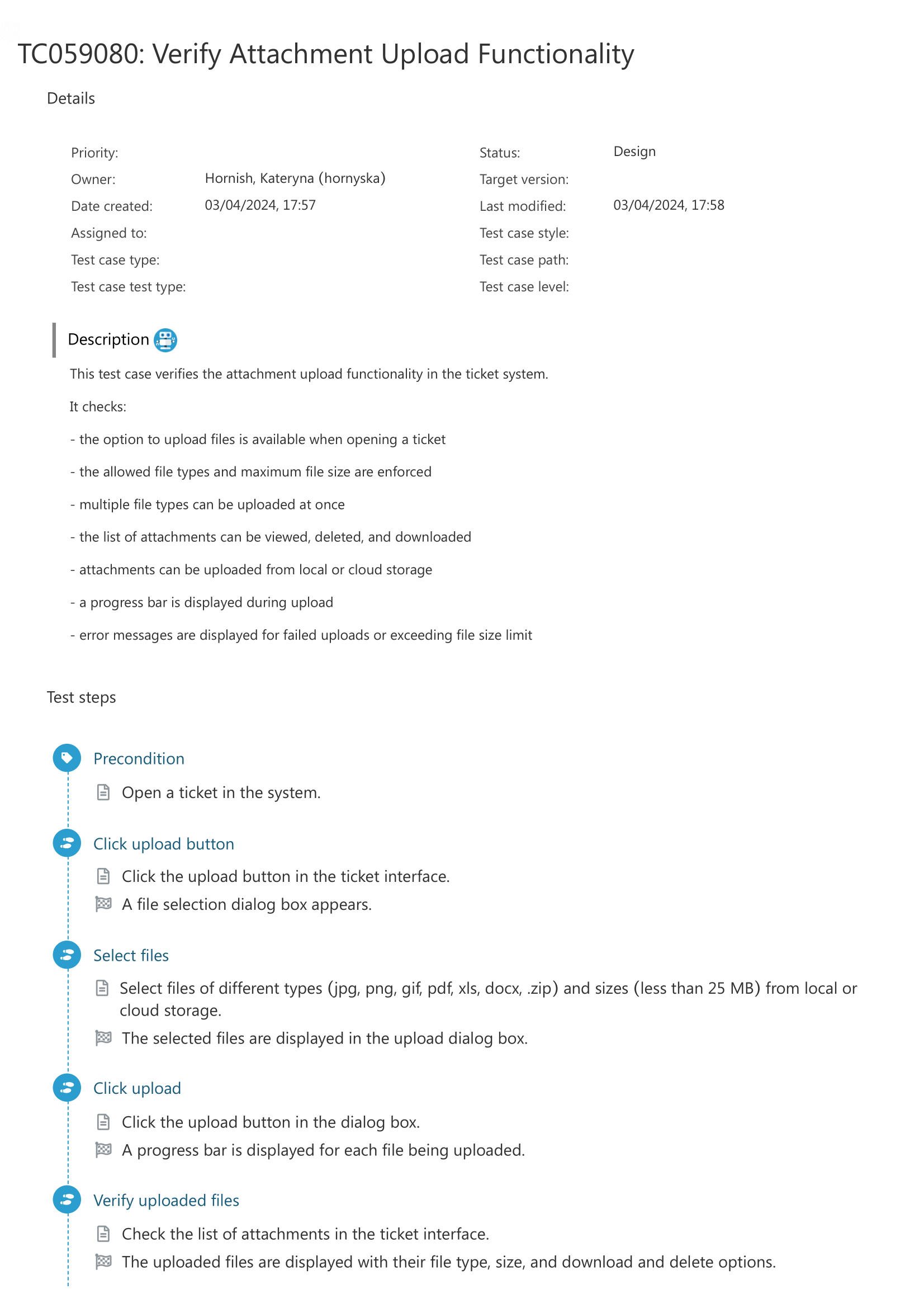What is generative AI in software testing?
Generative AI in software testing is the use of artificial intelligence models to automatically generate test cases, scripts, or even entire test environments. By analysing existing data and code, generative AI can help you create realistic and diverse scenarios. These accurate scenarios will empower you to identify potential bugs or issues more efficiently than traditional methods.
In practice, generative AI in software testing enables you to cover more ground in less time. This means improving test coverage and reducing manual effort. Some bold statistics are showing the widespread use of generative and overall AI in software testing:
- Forbes experts predict that the usage of AI will increase by over 37% in the next 6 years
- Capgemini report of 2019 revealed 57% of businesses use AI and ML for their testing efforts
- Another Capgemini report showed that using AI reduces test design and execution efforts by 30%
So the change generative AI brings is already here and will increase in the coming years. But why do businesses choose to do this? What are the main benefits?
AI makes QA more necessary because you will always need somebody to make sure that the robot isn't spitting out lies and actually does the thing it's supposed to be doing. At the end of the day, AI is just software and as software it needs testing.
Benefits of Using Generative AI in Software Testing
When you start using generative AI in testing, you benefit from the following outcomes:
- Automated Test Case Generation: With generative AI, you can automatically create diverse and comprehensive test cases by analysing code, user behaviour, and past bugs. This reduces your manual effort and ensures you cover more scenarios.
- Better Test Coverage: AI-generated test cases can cover a broader range of scenarios, including edge cases you might miss. AI test coverage leads to more complete testing and a higher chance of identifying potential issues before release.
- Faster Testing Cycles: By automating the generation and execution of tests, generative AI models help you reduce the time needed for testing cycles. This leads to quicker iterations and faster time-to-market.
- Improved Defect Detection: Generative AI in software testing can quickly identify patterns and anomalies that might indicate defects, even in complex environments. This improves defect detection accuracy and reduces the risk of unnoticed critical issues.
- Cost Efficiency: With generative AI handling repetitive and time-consuming tasks, you can reduce the cost of manual testing efforts while improving your software quality.
Generative AI in software testing deals with several pain points, most of which should already be familiar to you:
- Manual Test Creation: Creating test cases manually is time-consuming and prone to human error. Generative AI automates this process, creating more consistent and reliable test cases.
- Limited Test Coverage: Human testers often overlook certain scenarios, leading to gaps in test coverage. AI test coverage ensures a more comprehensive approach, covering more possibilities.
- Long Testing Cycles: Traditional testing methods often extend the development cycle. Generative AI accelerates testing without compromising quality.
If all these theoretical benefits sound appealing, let us introduce a practical solution to you – aqua cloud. aqua was the first solution in the QA industry to provide users with the power of generative AI. Aiming at perfect testing cycles, aqua empowers you with the following superpowers:
- AI-powered requirements creation: You can create a complete set of requirements with your voice, by speaking just a few words.
- Lightning-fast test case creation: From these requirements, you can create complete test cases in a few seconds, saving approximately an impressive 97% of your time compared to manual creation.
- Test data creation with AI: aqua’s AI also helps you generate test data in a few seconds, helping you achieve 100% test coverage.
All this means – most of your test cycle is covered WITH JUST 3 CLICKS. Ready for this complete transformation?
Use the power of generative AI to the fullest with just 3 clicks
Challenges of Generative AI in QA
Despite the above-mentioned benefits, using generative AI models in quality assurance also comes with its challenges. As you embrace this technology, it’s crucial to be aware of potential challenges:
- Complexity in implementation: Setting up generative AI requires a solid understanding of both AI and your specific testing environment. If you’re not familiar with these technologies, the learning curve will be steep.
- Limited human oversight: While generative AI can automate many tasks, it lacks the human intuition to catch nuanced issues, especially those related to user experience or business logic. You’ll still need human testers to review and validate the results.
- Data dependency: Generative AI relies heavily on the quality and quantity of data it’s trained on. If your data is incomplete or biased, the AI could produce inaccurate or subpar test cases.
- Integration with existing tools: Integrating AI with your current quality assurance tools and workflows requires significant customisation and can be time-consuming. We’ll cover this topic separately in this guide later.
- Ethical and bias concerns: AI systems can introduce biases into your testing processes. You need to ensure your AI models are trained on diverse datasets to avoid unwanted consequences.
- Over-reliance on automation: It’s easy to become overly reliant on AI for testing, as you want your efforts reduced. However, it’s important to remember that not all testing scenarios can be automated. You’ll still need manual testing to handle complex, non-repetitive tasks.
- Precise Prompting: When using AI tools, like chatbots or generative models, the quality of the output is only as good as the prompts you provide. Without a solid understanding of effective prompting techniques, you risk generating generic results that miss the mark. aqua cloud guides you to craft precise prompts that yield accurate and valuable results.
- Data Security: Generative AI models require access to your data to function effectively. It can raise significant security concerns, especially in enterprise environments. If your data isn’t properly secured, you run the risk of exposing sensitive information. aqua cloud addresses this by ensuring robust data protection protocols, using your data only for contextual purposes. It is a secure choice for you where data security is specifically crucial.
These challenges mean AI is not ready to fully take over (at least, yet). You still need human intuition, insights, and decision-making in the process.
There are various generative AI models, which we discuss next, that can assist with specific tasks but should be used with caution. While they offer significant benefits, it’s crucial to integrate them thoughtfully into your quality assurance processes to avoid the potential challenges we just mentioned.
Generative AI Model Types
Understanding various generative AI models can help you bring innovation into your quality assurance processes. These models differ in their purposes and we can group them like this:
- Test Case Generation Models: These models automatically create test cases based on your requirements or user stories, significantly speeding up your testing process (aqua cloud does just that).
- Test Data Generation Models: These models generate diverse and comprehensive test data sets, ensuring your tests cover all possible scenarios (aqua cloud also does that!).
- Code Synthesis Models: These models can generate code snippets or even entire functions, assisting you in creating automated tests or filling in gaps in your test suite.
- Scenario Simulation Models: These models generate realistic testing scenarios by simulating user behaviour or interactions within the software. They help you anticipate how your application will perform in different real-world conditions, ensuring your tests are robust and comprehensive.
These models have significant, specific benefits, and having a solution that combines a few of them feels like a cheat. As we mentioned already, aqua cloud is your generative AI superhero, just a few clicks away from transforming your manual efforts into an effortless process.
Integration of generative AI with other technologies
Integrating generative AI with existing technologies can greatly enhance your software testing capabilities. This process involves a few steps:
- Assessing your current tools,
- Selecting the appropriate AI models,
- Customising them to fit seamlessly into your workflows.
Once integrated, these AI models can work with your CI/CD pipelines, test automation frameworks, and cloud platforms. This collaboration improves efficiency, test coverage, and overall quality. However, continuous monitoring and optimisation are crucial to ensure that integration delivers the desired results.
Generative AI use case: aqua cloud
Enough with the theory, let’s show you something practical. As introduced above, aqua cloud is the master of generative AI and its capabilities. How so?
aqua cloud’s AI-powered test case generator
In this example, we’re focusing on how users can upload different types of files to a ticket system.

The goal is to make it easy for users to upload files like images, documents, or archives all at once. This will save time and improve user satisfaction by providing a simple way to share information. You create the requirement, click “Test It!”, and wait a few seconds.

Here’s the test case generated by aqua’s AI: This test case checks everything needed, from verifying file types and sizes to the upload screens and handling errors. It tests every step, including starting the upload, verifying the files, and dealing with errors like invalid file types or size limits. aqua’s AI completes this test case in just 13 seconds—98% faster than doing it manually!
To put it in perspective, creating this test case manually would take about 18 minutes. With aqua, it’s done in seconds. Imagine saving days of work when creating hundreds of test cases. aqua also allows you to customise the tests, including different types like positive, negative, functional, and performance tests. For larger requirements, aqua can also split test cases into smaller parts for better management. All while you will maintain speed and efficiency.
Apart from this, aqua also helps you with seamless requirements creation (from voice or text prompts) and test data generation. Is that it? No!
aqua cloud aims at just one thing: taking away the pain of testing. For this reason, aqua combines the following features with its 20 years of excellent experience:
- Centralised repository for all your testing and QA activities
- AI-Copilot that will be your guarding angel while navigating the platform
- Integration with automation frameworks like Selenium, Jenkins, and many more
- Bug-reporting beauty through its integration with Capture (visual bug recording tool)
It’s almost as if the benefits have no end. What’s keeping you from a complete transformation?
Save 98% of your time, energy, and resources with aqua’s AI
How to create a testing strategy with generative AI?
To create a testing strategy with generative AI, you need some key steps to cover all necessary aspects of your software testing process. By using AI, you can streamline the generation of requirements, test cases, and test data, making your testing more efficient and comprehensive.
Steps to Create a Testing Strategy with Generative AI:
- Define Testing Requirements:
- Use AI to automatically generate detailed testing requirements based on project specifications. This leads to clear and comprehensive guidelines for your tests.
- Generate Test Cases:
- Let AI create a wide range of test cases from your requirements. This includes positive, negative, functional, and edge cases. Make sure to cover various scenarios for thorough testing.
- Create Test Data:
- Use AI to generate diverse and realistic test data. This includes handling different data formats and edge cases to thoroughly test your application’s functionality.
- Automate Test Execution:
- Integrate generative AI with your test automation tools to run generated test cases. This automates the testing process, saving time and ensuring consistent execution.
- Analyse Test Results:
- Use generative AI to analyse test results and identify patterns or anomalies. This way, you can quickly pinpoint issues and understand the impact of bugs on your application.
- Optimise Testing Strategy:
- Continuously refresh and refine your testing strategy based on AI insights. Adjust test cases and data based on feedback and performance to improve overall testing efficiency.
With this approach, you can build a rock-solid testing strategy that maximises the power of generative AI. aqua cloud is the ultimate solution for this, bringing this superpower into several phases of the test cycle.
Okay, we can all agree that AI is revolutionary, despite its challenges. But is it dangerous? Where are we headed? Let’s touch on this hot topic also.
By far the greatest danger of Artificial Intelligence is that people conclude too early that they understand it.
The Future of Generative AI
In modern days, we see too many quotes like this and it makes us feel: is there a huge threat by AI to our efforts, jobs, or even personal lives?
While AI’s potential in software testing might seem terrifying, it’s crucial to focus on its future possibilities and how it can enhance our testing strategies. Rather than replacing human effort, AI is set to complement and elevate it. As the AI evolves, the scale you use will get bigger and more specific.
Here is how AI is expected to make significant strides in software testing:
- Predictive Testing: AI could anticipate potential issues by analysing historical data and predicting future problem areas before they occur.
- Adaptive Testing: AI can dynamically adjust test cases and strategies based on real-time data and changing conditions. This way, testing becomes more responsive and relevant.
- Intelligent Test Optimisation: AI could optimise test coverage and execution strategies by learning from past results, automatically prioritising tests based on their impact and relevance.
- Self-Healing Tests: Future AI might create tests that automatically adapt and correct themselves if they encounter failures or changes in the application.
However, human intuition, creativity, and decision-making will remain crucial. Generative AI can handle complex data and repetitive tasks, but it relies on your expertise to interpret results, make strategic decisions, and address nuanced issues that AI alone cannot fully understand.
"AI will enhance human capabilities and help us achieve more together, rather than replacing the human touch."
Integrating AI with your tools and skills will lead to a more effective and innovative testing process. Embracing this synergy, you will use the strengths of both generative AI and human insight to achieve superior results in software testing.
Even the content creator behind this article used generative AI to explain complex concepts more simply, so what could be the harm in it as long as it gets the results we want?
Conclusion
Generative AI is set to significantly improve software testing by automating tasks like test case creation and data generation, and by optimising how tests are run. Future advancements will bring even smarter automation testing tools, such as predictive and adaptive systems. However, human skills will always be essential. While generative AI handles routine tasks and data analysis, your creativity and judgment will guide its use effectively. By combining AI’s capabilities with your insights, you can enhance testing processes and achieve better results. The future of software testing looks promising, and with AI, you’re ready to make great strides. The question is, why wait for this future? Why not take action to use the full power of AI to deliver superior results? Just contact us and let us help you achieve that.


















